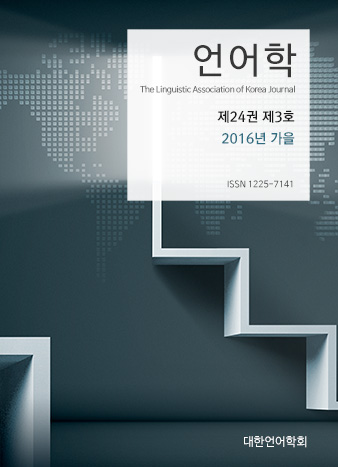대한언어학회 전자저널

24권 3호 (2016년 9월)
Abstract
Seo, Hongwon. (2016). Phonotactic Adaptation in Loanwords: Insertion vs. Deletion. The Linguistic Association of Korea Journal, 24(3), 37-62. The goal of this paper is to investigate what repair strategies can be employed when an illegitimate cluster is adapted into a language which lacks complex margins and how a typology can be dealt with within the framework of the Optimality Theory. Vowel insertion is cross-linguistically preferable over consonant deletion. This tendency is well supported by TCRS (Paradis & LaCharité 1997), but if more than one repair is necessary, deletion inevitably happens depending on perceptual salience and similarity. Concerning the position of vowel insertion, three types are all observed in loanword adaptation: only prothesis, only anaptyxis, and a mixed pattern. For the OT analysis, the ranking permutation between SYLLCON and CONTIGUITY can account for such an asymmetrical typology, in combination with some markedness constraints to comply with phonological restrictions.
Keywords
# loanword # insertion # deletion # phonotactic adaptation # perceptual similarity
References
- Adler, A. N. (2006). Faithfulness and perception in loanword adaptation: A case study from Hawaiian. Lingua 116: 1024-1045.
- Beckman, J. (1997). Positional faithfulness. Unpublished doctoral dissertation. University of Massachusetts, Amherst.
- Broselow, E. (1983), Salish double reduplications: subjacency in morphology. Natural Language and Linguistic Theory 1: 317-346.
- Broselow, E. (2015). The typology of position-quality interactions in loanword vowel insertion. In Y. Hsiao and L-H. Wee (eds.) Capturing Phonological Shades, 292-319. Cambridge Scholars Publishing.
- Côté, M-H. (2000). Consonant Cluster Phonotactics: A perceptual approach. Ph.D. dissertation, MIT.
- Elbert, S. H. & Pukui, M. K. (1979). Hawaiian Grammar, Honolulu: University Press of Hawaii.
- Fay, D. & Cutler, A. (1977) Malapropisms and the structure of the mental lexicon. Linguistic Inquiry 8(3), 505–520.
- Fleischhacker, H. A. (2005). Similarity in phonology: evidence from reduplication and loan adaptation. Unpublished doctoral Dissertation, University of California, Los Angeles.
- Jacobs, H. & Gussenhoven, C. (2000). Loan phonology: perception, salience, the lexicon and OT. In J. Dekkers, F. van der Leeuw & J. van de Weijer, (Eds.) Optimality Theory: Phonology, Syntax, and Acquisition, 193-210. Oxford: Oxford University Press.
- Kang, Y. (2011). Loanword phonology. In van Oostendorp, Marc, Colin Ewen, Elizabeth Hume, & Keren Rice, (Eds.), Companion to Phonology, Ⅳ. (pp. 2258-2283). Wiley-Blackwell.
- Lovins, J. B. (1975). Loanwords and the phonological structure of Japanese. Blookington, IN: Indiana University Lingusitics Club.
- McCawley, J. (1968). The phonological component of a grammar of Japanese. The Hague: Mouton.
- McCarthy, J. & Prince, A. S. (1995). Faithfulness and reduplicative identity. UMOP, 18, 249-384.
- Paradis, C. & LaCharité, D. (1997). Preservation and minimality in loanword adaptation. Journal of Linguistics 33, 379-430.
- Paradis, C. & LaCharité, D. (2005). Category preservation and proximity versus phonetic approximation in loanword adaptation. Linguistic Inquiry 36, 223-58.
- Prince, A. S. & Smolensky, P. (1993). Optimality theory: constraint interaction in generative grammar. Rutgers University, New Brunswick, and University of Colorado, Boulder.
- Prince, A. S. & Smolensky, P. (2004). Optimality theory: constraint interaction in generative grammar. MA: Blackwell.
- Smith, L. J. (2006). Loan phonology is not all perception: Evidence from Japanese loan doublets. In Timothy J. Vance and Kimberly A. Jones (eds.), Japanese/Korean Linguistics 14, 63-74.
- Steriade, D. (1997). Phonetics in phonology: the case of laryngeal neutralization. In Matthew Gordon (Ed.), Papers in Phonology 3. (UCLA Working Papers in Linguistics 2) Los Angeles: Department of Linguistics, UCLA, 25-146.
- Steriade, D. (2009) The phonology of perceptibility effects: The P-map and its consequences for constraint organization. In The nature of the word, Kristin Hanson & Sharon Inkelas, (Eds.), Cambridge: MIT Press, 151–179.
- Vennemann, T. (1988). Preference laws for syllable structure and the explanation of sound change. New York: Mouton de Gruyter.
- Yip, M. (2002). Necessary but not sufficient: Perceptual loanword influences in loanword phonology. The Journal of the Phonetic Society of Japan, Special Issue on Aspects of Loanword Phonology 6, 4-21.